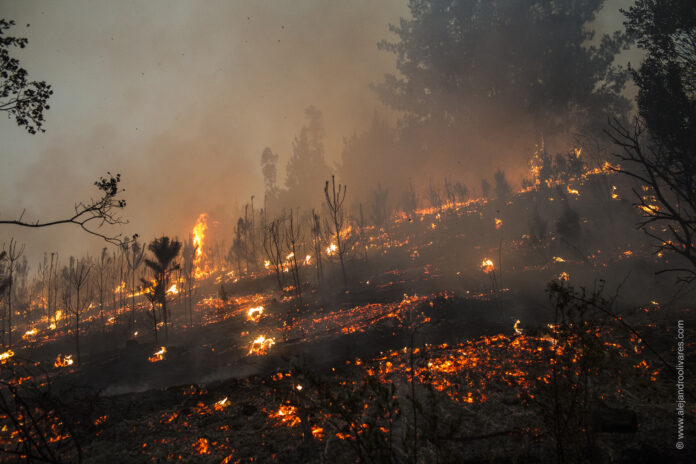Wildfires in the Valparaíso region of cen tral Chile produced the country’s highest human death toll from a natural disaster since its 2010 earthquake, prompting fresh legislation and debate on Chile’s growing incidence of large-scale conflagrations.
The Valparaíso fires started on Feb. 2 in the forested hills inside the Lago Peñuelas
National Reserve, located about 30 kilometers (20 miles) south of Viña del Mar and Quilpué.
It quickly expanded to the outskirts of both cities, ultimately killing 134 people—this century’s second-deadliest wildfire worldwide after Australia’s Black Saturday Bushfires in 2009.
The blazes, believed to have begun with an intentionally set fire, blackened over 10,000 hectares (25,000 acres) and destroyed thousands of homes in two days. Firefighters could not control flames that raced along stream valleys, incinerating entire streetscapes and neighbor-hoods. The blazes reached the coastal resort city of Viña del Mar, home to about 350,000 people, within six hours, burning parts of the city and
destroying its prized botanical gardens.
Elizabeth Wiggins of NASA’s Earth Applied Sciences Disasters program attributes
the wildfires’ fast spread to “perfect storm” conditions. “They occurred during a heatwave, drought and high-wind event borne of a combination of El Niño and climate change,” she says.
Dozens of fires also broke out in vari ous parts of southern Chile during the austral summer. In late January, megafires spread near Puerto Montt and Lonquimay in the La Araucanía region, charring over 3,000 hectares (7,400 acres). There have been over 5,000 fires so far in Chile during the 2023-24 fire season.
Chile was not alone. Wildfires also scorched two national parks in southern Argen-
tina in the first two months of the year. In Los Alerces National Park, nearly 7,000 hectares (17,000 acres) burned, as did 450 hectares (1,100 acres) at Nahuel Huapi National Park, located near the popular Patagonia resort Bariloche.
Nor was the Southern Cone alone in grappling with fires. In January, wildfires in Colom-
bia burned 17,000 hectares (42,000 acres) and dry conditions in the northern Amazon have led to a record number of fires there. According to Brazil’s National Institute of Space Research, Venezuela, northern Brazil, Guyana and Suriname have experienced the highest number of fires for any February on record.
For Chile, the fire threat was no surprise. In September, the government of President Gabriel Boric issued a “Preventive Emergency Decree” for all 13 regions of the country, expanding the official fire season from October to May after decades of it being considered to occur from December to March.
Climate change cited
Experts attribute the growing danger to the worldwide climate crisis, which they say is
helping to make wildfires larger as well as more frequent and intense. Last year, fires in Chile burned 400,000 hectares (990,000 acres) and cost over US$300 million to extinguish. These fires are happening in a context of record-break-ing heat waves, severe drought, less snow, and punishing winds that propel fires such as those
in Valparaíso at unprecedented speeds.
Posing particular risk are massive tree plantations, which cover over three million
hectares (7.4 million acres) of central-southern Chile, from the Valparaíso region to the La Araucanía region. (See “Growing fire risk fuels tree-plantation doubts”—EcoAméricas, Nov. ’23.) Consisting of row upon row of fast growing, non-native pine and eucalyptus, the plantations are highly flammable.
Aníbal Pauchard, director of the Institute of Ecology and Biodiversity at the University of Concepción, cites water stress and tree plantations as key contributors to the fires’ speed and destructiveness. “The insigne pine [Pinus radiata] and eucalyptus [Eucalyptus globulus] burn relatively quickly, and we have other invasive shrub species there that generate a very high amount of fuel,” Pauchard says.
The growing damage caused by wildfires has prompted calls for action in recent years,
but the extreme loss of life in the Valparaíso region appears to have pushed the country past a tipping point. In March, the lower house of the Chilean Congress, the Chamber of Depu ties, rapidly and overwhelmingly passed new fire legislation—the Forest and Rural Fire Law, which was introduced in October 2023.
The legislation, now pending in the Senate, would require firebreaks, establish urban-
rural interface zones, and empower authorities to develop fire-prevention land-use regulations for those areas. It would assign private land-owners “co-responsibility” with Chile’s Forest Service (Conaf) for filing land-management plans that include fire-mitigation measures.
Land-use restrictions
The legislation, which focuses on large and small communities as well as rural areas,
imposes certain land-use restrictions on burn areas in order to prioritize the reestablishment of forest and plant cover. The measure has drawn broad criticism for not including a ban on new real estate development in burn areas.
The Chilean Senate, however, may restore this and other measures in its version of the bill.
Mauro González, a researcher at the Center for Climate and Resilience Research (CR2) and a professor at Austral University of Chile in Valdivia, calls the new fire law a good step forward. But González says the country also must initiate farther-reaching action and policies to change land-use patterns.
“We need other land-use laws that push [plant and tree] cover away from flammable
conditions,” he says, “such as eliminating the exotic-species tree plantations in some areas, improving land management of other existing plantations, and changing these areas to other types of land cover that are more resilient and less vulnerable to the new climate conditions.”
Chilean Environment Minister Maisa Rojas, a scientist who previously worked as a
researcher on climate change issues, says Chile’s Framework Law on Climate Change provides tools to combat the fire threat. But in a radio interview, Rojas argued that Chile must also have new means of confronting a climate crisis that will require “living together in a different way with our landscapes.”
Said Rojas: “The truth is that when one travels around the country, one sees firebreaks in many places. It is noticeable, but not everywhere because there is no law that obligates it; and in that, the fire law could help.” | Leer en EcoAméricas (publicación en inglés)

